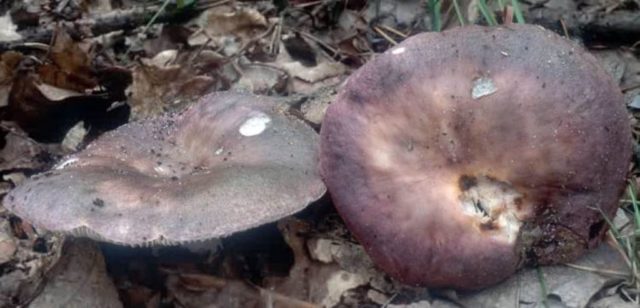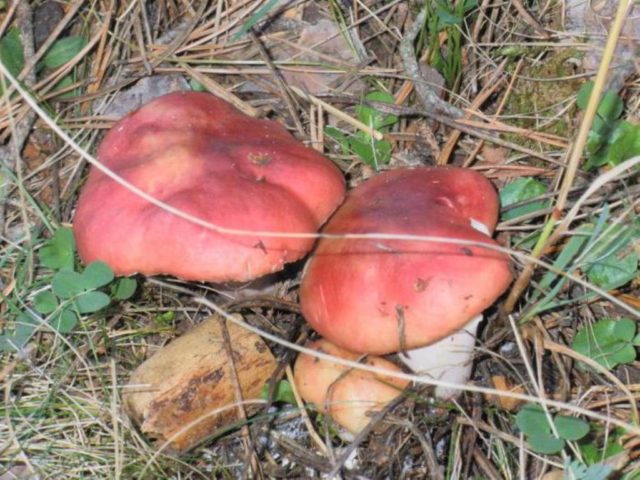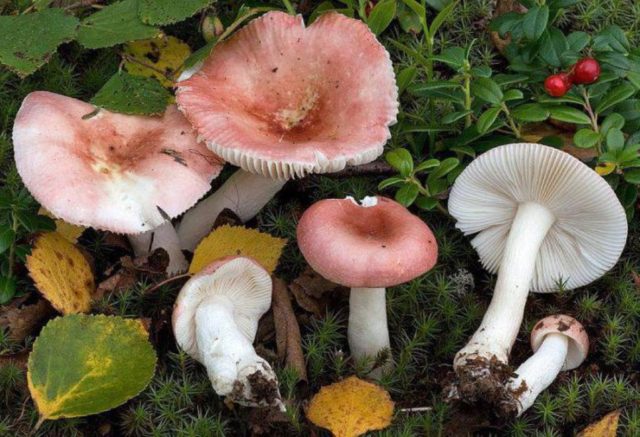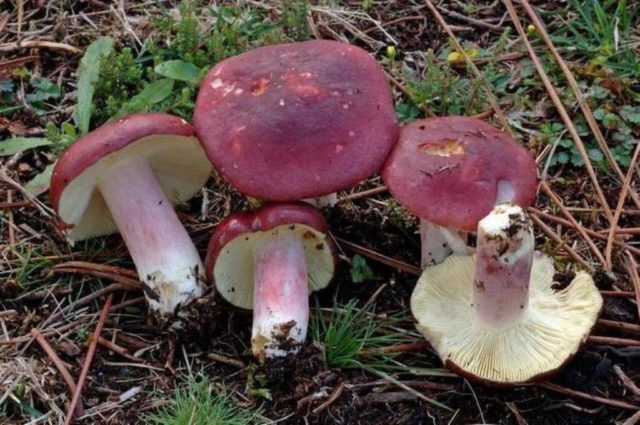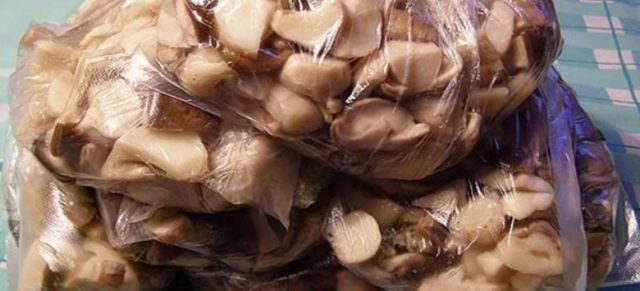Content
The blue and yellow russula is a delicious, nutritious mushroom that is ideal for making culinary delights. You can recognize the species by a blue-green or purple hat and an elastic, fleshy leg. In order not to make a mistake in choosing and not to collect false doubles, you must carefully read the description, view photos and videos.
Where blue-yellow russules grow
The russula blue-yellow prefers to grow in families or singly in deciduous, spruce and mixed forests, on acidified soil. They can be found from July to the end of August in the lowlands and mountains.
What do russula blue-yellow look like?
Despite the name, the hat of the blue-yellow russula can be painted in a variety of colors. In order not to collect false mushrooms, you must familiarize yourself with the description of the species:
- Smooth cap with a blurry color. It can be blue-green, violet-gray, purple or pink. The convex shape straightens over time and forms a pronounced depression in the center.
- The cap size reaches 16 cm.
- After rain, the bright surface becomes glossy and covered with mucus.
- The bottom of the cap is covered with dense snow-white plates, oily to the touch.
- The pulp is dense, odorless.
- The leg is thick, fleshy, cylindrical, about 10 cm long.
- With age, the flesh of the leg becomes loose and cotton-like.
- The color of the scales is snow-white with a purple tint.
- In case of mechanical damage, the pulp does not darken.
- The taste is pleasant, mushroom or nutty.
Is it possible to eat blue-yellow russula
The blue-yellow russula belongs to the 3rd group of edibility. For its good taste, the species is popular in Europe. It is suitable for consumption without prior boiling.
Mushroom taste
Due to its delicate mushroom or nutty taste, the blue-yellow russula is consumed fried, stewed and salted. Small examples look great in marinades and soups.
Benefits and harm to the body
Blue-yellow russula contains vitamins, amino acids and trace elements. Therefore, it is recommended to use it for many diseases. The species is low in calories and easily satisfies hunger. They do not contain fats, so mushroom dishes are great for people who take care of their health.
With regular use, the blue-yellow russula stops the growth of cancer cells, strengthens the walls of blood vessels and the heart muscle. Due to the high content of B vitamins, the nervous system is strengthened, immunity is increased, the symptoms of stress and depression disappear.
Despite the beneficial properties, mushroom dishes are considered heavy food. Therefore, they cannot be used:
- children under 7 years old;
- pregnant and lactating women;
- with gastrointestinal diseases;
- with gout;
- with renal and hepatic insufficiency.
False doubles
Few mushroom pickers know that the blue-yellow russula has inedible "brothers". In order not to harm your body, you need to know the distinctive properties:
- the flesh is very dense and strong;
- the cap is brightly colored, it can be bright red, lilac-pink with a sharp darkening in the center;
- regardless of the weather, the surface is slimy and glossy;
- the base of the leg is colored scarlet or pink;
- the lamellar layer is rough and dense;
- during heat treatment and mechanical damage, the pulp changes color;
- the leg is surrounded by a thin film.
The most common types of inedible twins are:
- Bilious - prefers coniferous forests and acidic soil. It can be found in forests from mid-July to early October. The species has a small straw-lemon-colored cap, a hollow, light yellow leg no more than 7 cm long. The snow-white pulp is bitter and emits an unpleasant aroma.
- Corrosive russula - a poisonous species, the pulp of which contains muscarine, which can lead to food poisoning. This species has a reddish, dense cap and a cylindrical pink stem. The russula has a bitter-burning taste, no aroma
- Birch - an inedible species with a bitter, pungent taste. When used, nausea, vomiting, pain in the epigastric region may appear. This species prefers to grow in birch and spruce forests, in marshy and humid areas. Grows from late June to early November. The small cap is brittle and fleshy. The color of the cap can be from pale pink to deep purple. The stem is fibrous, hollow, soaking in rainy weather.
- Russula sardonyx - a poisonous mushroom, when consumed can lead to an upset of the gastrointestinal tract. The 10 cm hat is colored red or brown with a purple tint. The pulp is dense, bitter, with a delicate fruity aroma.
If the first signs of poisoning are noticed, it is necessary to call a medical team. Before the ambulance arrives:
- wash the stomach;
- take laxative and activated charcoal;
- put heat on the epigastric region and legs;
- get rid of tight clothes.
Collection rules
To collect healthy and tasty mushrooms without compromising the body, you need to heed the recommendations for collection.
- Since the mushroom pulp quickly absorbs toxins and heavy metals, you should not take the blue-yellow russula growing along the motorway and in the industrial area.
- The collection is carried out in the morning, in dry sunny weather.
- Blue-yellow russules, so that they do not crumble and have a marketable appearance, are collected in shallow baskets made of natural material.
- You should pass by unfamiliar specimens, since you can often find poisonous counterparts of the blue-yellow russula in the forest.
- It is advisable to collect only young mushrooms, since they have a dense pulp structure, they are less often wormy.
- So that the mushrooms do not change color and appearance, cleaning and processing are carried out in the near future.
Use
Blue-yellow russula is a healthy and very tasty mushroom with a nutty taste and a pleasant smell. There are many recipes for making blue-yellow russula.
Russula soup
The dish can be prepared from fresh mushrooms with the addition of vegetables, noodles or a variety of cereals.
Required products:
- mushrooms - 500 g;
- liquid - 2.5 l;
- onions and carrots - 2 pcs.;
- potatoes - 5 pcs.;
- spices to taste.
Preparation:
- The russula are washed, peeled and boiled for 10 minutes in salted water.
- Sliced potatoes are added.
- After 10 minutes, lay the carrot and onion fry.
- At the end of cooking, add your favorite spices.
Dumplings with blue-yellow russula
A delicious, nutritious dish that everyone, without exception, will enjoy.
Products:
- liquid - 250 ml;
- flour - 600 g;
- margarine - 50 g;
- egg - 1 pc.;
- mushrooms - 700 g;
- onions - 2-3 pcs.;
- spice.
Preparation:
- Mix flour, eggs, melted margarine, water and knead the elastic dough.
- The dough is covered with foil and left in a warm room for 40 minutes.
- The russula and onion are cut into small cubes and fried in vegetable oil.
- The dough is rolled out and blanks for dumplings are made with the help of a glass.
- Put the cooled filling in each circle, pinch the edges and boil in salted water for about 10 minutes.
- The dish is served with sour cream and fresh herbs.
Frozen russula
If there are a lot of russula, then they can be dried or frozen. Freezing is a simple, easy way that retains its appearance and taste for a long time. Thawed mushrooms are not frozen again. Freezing blue-yellow russula:
- The mushrooms are sorted out, peeled and boiled.
- After they sink to the bottom, they are transferred to a colander to get rid of excess moisture.
- After drying, the russula are laid out in containers or bags and sent to the freezer.
Conclusion
The blue and yellow russula is a delicious, nutritious mushroom. It clearly reveals its taste when fried, stewed and canned. The russula has false counterparts, therefore, during mushroom hunting, you must adhere to the recommendations of experienced mushroom pickers and know the description of the species.

